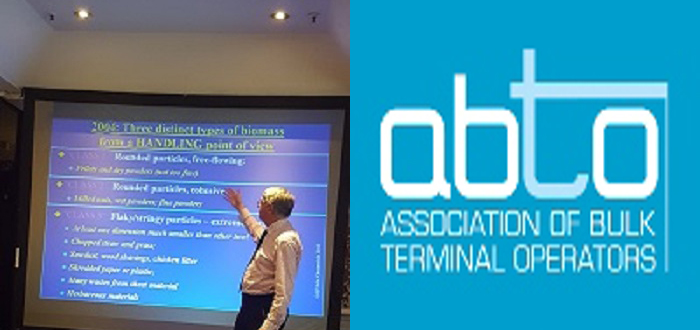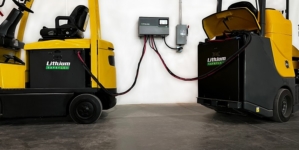-
ROSSLARE EUROPORT TARGETS HEALTH & SAFETY WITH CAMERA TELEMATICS PARTNERSHIP - 2 days ago
-
Landmark Study Reveals Wearable Robotics Significantly Boost Safety and Efficiency in Industrial Environments - July 24, 2024
-
Visku Tackle The Retail Seasonality Challenge One Pallet At A Time - July 22, 2024
-
KAMMAC AND BERGEN LOGISTICS STRENGTHEN FASHION & LIFESTYLE SERVICES IN THE UK - July 19, 2024
-
TENTBOX EXTENDS PARTNERSHIP WITH ARROWXL TO SUPPORT INCREASING DEMAND - July 17, 2024
-
The Perfume Shop improves customer journeys while driving profitability in partnership with Scurri - July 17, 2024
-
ZEROMISSION SECURES £2.3M ($3M) INVESTMENT TO ACCELERATE ELECTRIC FLEETS - July 16, 2024
-
BCMPA CELEBRATES SUCCESS OF 2024 CONFERENCE - July 15, 2024
-
Best of the Best: Jungheinrich Celebrates Triple International Award Win - July 12, 2024
-
GOPLASTICPALLETS.COM CALLS ON NEW CHANCELLOR RACHEL REEVES TO CONSIDER PLASTIC PACKAGING TAX REFORM - July 10, 2024
TERMINAL OPERATORS FACE A BIOMASS CHALLENGE.
Picture shows: Professor Mike Bradley explaining that the accumulation of biomass dust can increase the fire and explosion risks, particularly as some biomass cargoes are self-heating
The challenges facing bulk terminal operators looking to make the transition from coal to biomass were put into sharp focus at the Association of Bulk Terminal Operators’ inaugural conference, Bulk Terminals 2017, which took place last week in London.
“Biomass is not one material,” said Professor Mike Bradley, Director of the Wolfson Centre, urging terminal operator delegates at the conference to carefully evaluate the various types of biomass products before investing in new handling and storage facilities.
“Different biomass products have different requirements,” he said, explaining that biomass products can be made up of anything from organic residues, food waste, sewage, straw, cereal and olive stones to chipped wood, elephant grass, wet leaves and paper.
“The key is to understand the properties of the particular range of materials involved since no one handling system can deal with all types of biomass.”
Going on to highlight some of the unloading and handling challenges faced by operators looking to adapt their terminals for biomass, he advised operators to keep a close eye on their quality control and safety procedures. Biomass dust, he said, is a particular challenge.
“Dust has caught more people out in biomass handling,” he said. “It’s more mobile, it’s lighter and will stay suspended for longer.” He said there is a danger that if not dealt with appropriately, it could result in terminal workers inhaling the dust and contracting “farmer’s lung”, the accumulation of mould spores in the lungs.
Bradley also said that the accumulation of biomass dust can increase the fire and explosion risks, particularly as some biomass cargoes are self-heating.
“If you can write your name in the dust, you have an accident waiting to happen.”
The storage of biomass products, specifically wood pellets, was a key point raised by TBA’s Dr Mi-Rong (Kimberly) Wu. She informed more than 50 bulk industry leaders that biomass volume, rather than weight, has to be taken into account when considering silos and storage facilities.
She said that because of its bulk density, more volume of solid biomass needs to be stored compared to coal and this would require about 1.3 times more land to accommodate the higher volumes. Wu also said that solid biomass is sensitive towards degradation and should not be stored for more than three months.
“Silos have been known to explode because of incorrect handling. For solid biomass products, temperature and CO emissions must be constantly monitored,” she told delegates.
Summing up her presentation, she said: “Solid biomass properties are in a wide variation range. For solid biomass handling, the volumetric performance should be the main benchmark rather than tonnage performance.”
For those terminal operators considering a transition from coal to biomass, she said adjustments in terms of handling processes and storage requirement are necessary, along with in-depth investigations into logistics and material characteristics.
The biomass sessions were nicely rounded off by David Wragg, Business Development Director at Hargreaves Industrial Services, and Gary Sharpe, Project Director (Mersey) Peel Ports Group, both of whom provided insightful case studies of terminals that have successfully made the transition to biomass.
Wragg’s presentation focused on the safety systems and technologies Hargreaves has installed in the Port of Tyne’s new biomass-handling facility, while Sharpe detailed the infrastructure developments required of Merseyside’s Gladstone Biomass facility to handle 3Mtpa of wood pellets.
The latter project required three 100,000t capacity silos, 1.2km x 1.8m wide belt conveyors rated at 2000t/h, and rail infrastructure for ten trains each capable of handing1700t per day.
Commenting on the success of the Bulk Terminals 2017 conference, ABTO CE Ian Adams said: “The topics explored over the two-days provided operators with a great deal of information on how best to optimise operations for greater energy, environmental and cost efficiencies. It was very satisfying to know that all delegates left the conference – our first event since establishing the Association 18 months ago – commenting on the high quality of the papers presented. We have seen a significant growth in ABTO membership over the last few months and anticipate this continuing.”

































